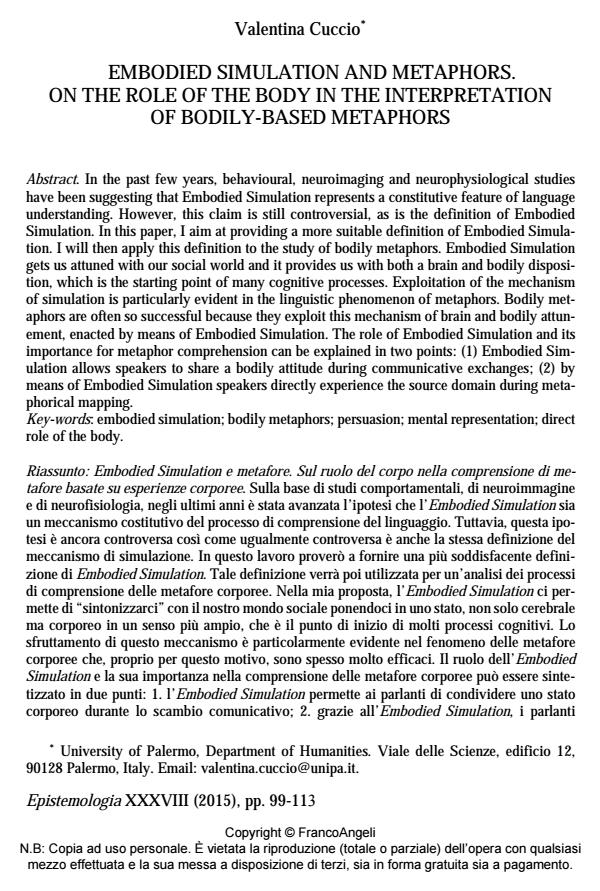Embodied simulation and metaphors. On the role of the body in the interpretation of bodily-based metaphors
Titolo Rivista EPISTEMOLOGIA
Autori/Curatori Valentina Cuccio
Anno di pubblicazione 2015 Fascicolo 2015/1
Lingua Inglese Numero pagine 15 P. 99-113 Dimensione file 95 KB
DOI 10.3280/EPIS2015-001007
Il DOI è il codice a barre della proprietà intellettuale: per saperne di più
clicca qui
Qui sotto puoi vedere in anteprima la prima pagina di questo articolo.
Se questo articolo ti interessa, lo puoi acquistare (e scaricare in formato pdf) seguendo le facili indicazioni per acquistare il download credit. Acquista Download Credits per scaricare questo Articolo in formato PDF

FrancoAngeli è membro della Publishers International Linking Association, Inc (PILA)associazione indipendente e non profit per facilitare (attraverso i servizi tecnologici implementati da CrossRef.org) l’accesso degli studiosi ai contenuti digitali nelle pubblicazioni professionali e scientifiche
In the past few years, behavioural, neuroimaging and neurophysiological studies have been suggesting that Embodied Simulation represents a constitutive feature of language understanding. However, this claim is still controversial, as is the definition of Embodied Simulation. In this paper, I aim at providing a more suitable definition of Embodied Simulation. I will then apply this definition to the study of bodily metaphors. Embodied Simulation gets us attuned with our social world and it provides us with both a brain and bodily disposition, which is the starting point of many cognitive processes. Exploitation of the mechanism of simulation is particularly evident in the linguistic phenomenon of metaphors. Bodily metaphors are often so successful because they exploit this mechanism of brain and bodily attunement, enacted by means of Embodied Simulation. The role of Embodied Simulation and its importance for metaphor comprehension can be explained in two points: (1) Embodied Simulation allows speakers to share a bodily attitude during communicative exchanges; (2) by means of Embodied Simulation speakers directly experience the source domain during metaphorical mapping.
Sulla base di studi comportamentali, di neuroimmagine e di neurofisiologia, negli ultimi anni è stata avanzata l’ipotesi che l’Embodied Simulation sia un meccanismo costitutivo del processo di comprensione del linguaggio. Tuttavia, questa ipotesi è ancora controversa così come ugualmente controversa è anche la stessa definizione del meccanismo di simulazione. In questo lavoro proverò a fornire una più soddisfacente definizione di Embodied Simulation. Tale definizione verrà poi utilizzata per un’analisi dei processi di comprensione delle metafore corporee. Nella mia proposta, l’Embodied Simulation ci permette di "sintonizzarci" con il nostro mondo sociale ponendoci in uno stato, non solo cerebrale ma corporeo in un senso più ampio, che è il punto di inizio di molti processi cognitivi. Lo sfruttamento di questo meccanismo è particolarmente evidente nel fenomeno delle metafore corporee che, proprio per questo motivo, sono spesso molto efficaci. Il ruolo dell’Embodied Simulation e la sua importanza nella comprensione delle metafore corporee può essere sintetizzato in due punti: 1. l’Embodied Simulation permette ai parlanti di condividere uno stato corporeo durante lo scambio comunicativo; 2. grazie all’Embodied Simulation, i parlanti fanno diretta esperienza del dominio di origine della metafora durante la costruzione dell’analogia tra questo e il dominio bersaglio.
Parole chiave:Embodied Simulation; metafore corporee; persuasione; rappresentazione mentale; ruolo diretto del corpo
- Ucieleśniona duchowość w dyskursie polskich protestantów pentekostalnych. Analiza wybranych metafor Karolina Bogacz-Kańka, in Studia Religiologica /2025 pp.39
DOI: 10.4467/20844077SR.24.012.21502 - Metaphors and Analogies in Sciences and Humanities Valentina Cuccio, Mario Graziano, pp.87 (ISBN:978-3-030-90687-0)
- Bodies, Ontology, and Bioarchaeology Ann M. Palkovich, pp.127 (ISBN:978-3-031-56022-4)
- Review of Littlemore (2019): Metaphors in the Mind. Sources of Variation in Embodied Metaphor Valentina Cuccio, in Metaphor and the Social World /2021 pp.367
DOI: 10.1075/msw.00024.cuc - What makes a Figure Anna Piata, Aristea-Maria Metaxa, pp.194 (ISBN:9789027224248)
Valentina Cuccio, Embodied simulation and metaphors. On the role of the body in the interpretation of bodily-based metaphors in "EPISTEMOLOGIA" 1/2015, pp 99-113, DOI: 10.3280/EPIS2015-001007